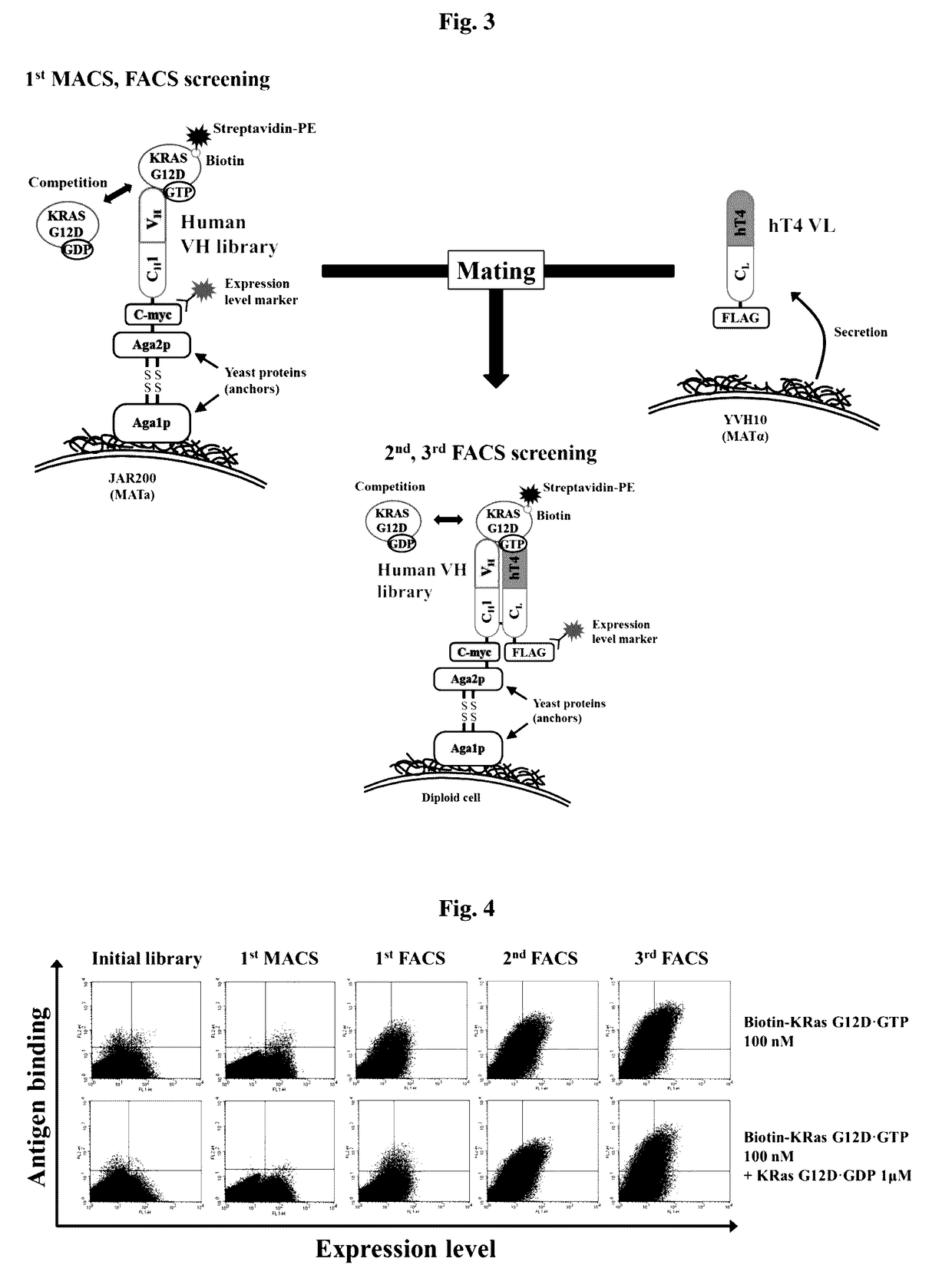Method for inhibiting intracellular activated ras using intact immunoglobulin-type antibody having cytosol-penetrating ability and use thereof
a technology of immunoglobulin-type antibody and cytosol penetrating ability, which is applied in the direction of instruments, drug compositions, peptides, etc., can solve the problems of antibodies and macromolecular bio-drugs, the inability of conventional antibodies to directly penetrate living cells, and the inability of conventional antibodies to pass the hydrophobic cell membran
- Summary
- Abstract
- Description
- Claims
- Application Information
AI Technical Summary
Benefits of technology
Problems solved by technology
Method used
Image
Examples
example 1
of Heavy-Chain Variable Region (VH), which Binds Specifically to GTP-Bound KRas, by High-Diversity Human VH Library
[0194]FIG. 1 is a schematic view showing a strategy of inducing cytotoxicity specific for Ras mutant cells by use of a monoclonal antibody (anti-Ras. GTP iMab: internalizing & interfering monoclonal antibody) which is constructed by replacing the heavy-chain variable region (VH) of an IgG-type cytotransmab (having only cytosol-penetrating ability) with a heavy-chain variable region (VH) binding specifically to GTP-bound KRas and which penetrates cells and binds specifically to GTP-bound Ras in the cytosol.
[0195]FIG. 2 is a schematic view showing a method of constructing anti-Ras•GTP iMab by replacing the heavy-chain variable region (VH) of an intact IgG-type cytotransmab, which has only cytosol-penetrating ability, with a heavy-chain variable region (VH) which binds specifically to GTP-bound KRas.
[0196]Specifically, the FR (framework) of the library used was the V gene ...
example 2
on of GTP-Bound KRas G12D Protein
[0198]Expression in E. coli and purification, performed to prepare GTP-bound KRas G12D antigen for library screening and affinity analysis, are described in detail in a previously reported paper (Tanaka T et al., 2007).
[0199]Specifically, a DNA encoding residues 1 to 188, which comprises the CAAX motif of each of wild-type KRas and mutant KRas G12D, KRas G12V and KRas G13D (listed in the order of higher to lower mutation frequency), was cloned into the E. coli expression vector pGEX-3X by use of the restriction enzymes BamHI / EcoRI. Herein, the expression vector was designed to have a T7 promoter-GST-KRas. All KRas mutations were induced using an overlap PCR technique, and the expression vector was constructed using the above-described method. The pGEX-3X-KRas vector was transformed into E. coli by electroporation, and selected in a selection medium. The selected E. coli was cultured in LB medium in the presence of 100 μg / ml of an ampicillin antibioti...
example 3
of Heavy-Chain Variable Region (VH) Specific for GTP-Bound KRas G12D
[0201]FIG. 15 is a schematic view showing a library screening strategy for obtaining a humanized antibody heavy-chain variable single domain having a high affinity only for GTP-bound KRas G12D protein.
[0202]Specifically, GTP-bound KRas G12D purified in Example 14 was biotinylated (EZ-LINK™ Sulfo-NHS-LC-Biotinylation kit (Pierce Inc., USA)), and then reacted with a heavy-chain variable region library displayed on the yeast cell surface at room temperature for 1 hour. The heavy-chain variable region library on the yeast cell surface, which reacted with the biotinylated GTP-bound KRas G12D, was reacted with Streptavidin (Microbead™ (Miltenyi Biotec) at 4° C. for 20 minutes, and then yeast displaying a heavy-chain variable region having a high affinity for the GTP-KRAS G12D was enriched using MACS (magnetic activated cell sorting). The selected library-displaying yeast was cultured in a selection medium and cultured in ...
PUM
| Property | Measurement | Unit |
|---|---|---|
| Length | aaaaa | aaaaa |
| Length | aaaaa | aaaaa |
| Length | aaaaa | aaaaa |
Abstract
Description
Claims
Application Information
 Login to View More
Login to View More - R&D
- Intellectual Property
- Life Sciences
- Materials
- Tech Scout
- Unparalleled Data Quality
- Higher Quality Content
- 60% Fewer Hallucinations
Browse by: Latest US Patents, China's latest patents, Technical Efficacy Thesaurus, Application Domain, Technology Topic, Popular Technical Reports.
© 2025 PatSnap. All rights reserved.Legal|Privacy policy|Modern Slavery Act Transparency Statement|Sitemap|About US| Contact US: help@patsnap.com



